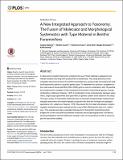Files in this item
A new integrated approach to taxonomy : the fusion of molecular and morphological systematics with type material in benthic foraminifera
Item metadata
| dc.contributor.author | Roberts, Angela Dawn | |
| dc.contributor.author | Austin, William | |
| dc.contributor.author | Evans, Katharine | |
| dc.contributor.author | Bird, Clare | |
| dc.contributor.author | Schweizer, Magali | |
| dc.contributor.author | Darling, Kate | |
| dc.date.accessioned | 2016-07-08T16:30:13Z | |
| dc.date.available | 2016-07-08T16:30:13Z | |
| dc.date.issued | 2016-07-07 | |
| dc.identifier | 244115636 | |
| dc.identifier | 4e126b2e-1e38-4f1a-ab52-8bbaf4fe4728 | |
| dc.identifier | 84978631958 | |
| dc.identifier | 000379811500042 | |
| dc.identifier.citation | Roberts , A D , Austin , W , Evans , K , Bird , C , Schweizer , M & Darling , K 2016 , ' A new integrated approach to taxonomy : the fusion of molecular and morphological systematics with type material in benthic foraminifera ' , PLoS One , vol. 11 , no. 7 , e0158754 . https://doi.org/10.1371/journal.pone.0158754 | en |
| dc.identifier.issn | 1932-6203 | |
| dc.identifier.uri | https://hdl.handle.net/10023/9099 | |
| dc.description | This work was supported by NERC grant NE4/G018502/1 and NE/G020310/1 (Website: http://www.nerc.ac.uk). The authors also thank the following for their support the Carnegie Trust for the Universities of Scotland (Website: http://www.carnegie-trust.org) and the Estuarine Coastal and Shelf Science Association (Website: http://www.ecsanews.org). M.S. was also supported by the Swiss National Science Foundation (SNSF), fellowships for advanced researchers PA00P2_126226 and PA00P2_142065 (Website: http://www.snf.ch/en/Pages/default.aspx). | en |
| dc.description.abstract | A robust and consistent taxonomy underpins the use of fossil material in palaeoenvironmental research and long-term assessment of biodiversity. This study presents a new integrated taxonomic protocol for benthic foraminifera by unequivocally reconciling the traditional taxonomic name to a specific genetic type. To implement this protocol, a fragment of the small subunit ribosomal RNA (SSU rRNA) gene is used in combination with 16 quantitative morphometric variables to fully characterise the benthic foraminiferal species concept of Elphidium williamsoni Haynes, 1973. A combination of live contemporary topotypic specimens, original type specimens and specimens of genetic outliers were utilised in this study. Through a series of multivariate statistical tests we illustrate that genetically characterised topotype specimens are morphologically congruent with both the holotype and paratype specimens of E. williamsoni Haynes, 1973. We present the first clear link between morphologically characterised type material and the unique SSU rRNA genetic type of E. williamsoni. This example provides a standard framework for the benthic foraminifera which bridges the current discontinuity between molecular and morphological lines of evidence, allowing integration with the traditional Linnaean roots of nomenclature to offer a new prospect for taxonomic stability. | |
| dc.format.extent | 4098404 | |
| dc.language.iso | eng | |
| dc.relation.ispartof | PLoS One | en |
| dc.subject | QH301 Biology | en |
| dc.subject | DAS | en |
| dc.subject | BDC | en |
| dc.subject | R2C | en |
| dc.subject.lcc | QH301 | en |
| dc.title | A new integrated approach to taxonomy : the fusion of molecular and morphological systematics with type material in benthic foraminifera | en |
| dc.type | Journal article | en |
| dc.contributor.sponsor | NERC | en |
| dc.contributor.institution | University of St Andrews. School of Geography & Sustainable Development | en |
| dc.contributor.institution | University of St Andrews. Marine Alliance for Science & Technology Scotland | en |
| dc.contributor.institution | University of St Andrews. Scottish Oceans Institute | en |
| dc.contributor.institution | University of St Andrews. St Andrews Sustainability Institute | en |
| dc.contributor.institution | University of St Andrews. Geography & Sustainable Development | en |
| dc.contributor.institution | University of St Andrews. School of Geography and Geosciences | en |
| dc.identifier.doi | 10.1371/journal.pone.0158754 | |
| dc.description.status | Peer reviewed | en |
| dc.identifier.url | http://journals.plos.org/plosone/article?id=10.1371/journal.pone.0158754#sec023 | en |
| dc.identifier.grantnumber | NE/G018502/1 | en |
This item appears in the following Collection(s)
Items in the St Andrews Research Repository are protected by copyright, with all rights reserved, unless otherwise indicated.

